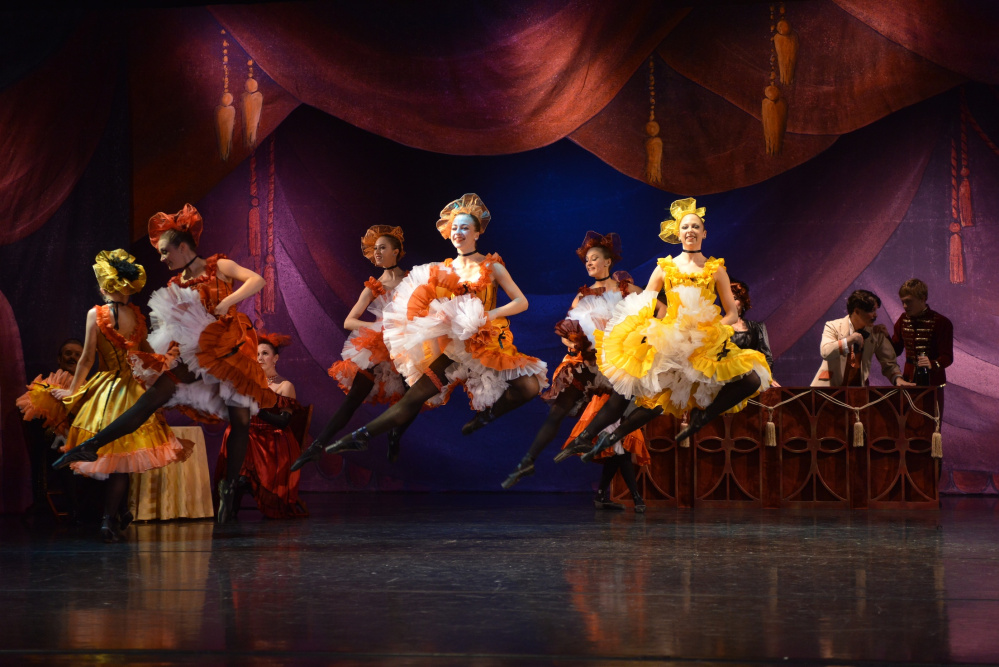Maine State Ballet’s summer offering is a double bill that exemplifies the range of the company.
In the classical “Raymonda” (selections) and the humorous one-act ballet “Can-Can Parisien,” dancers show stylistic versatility along with professional polish that is all the more impressive considering the short rehearsal period of a summer season embedded in Maine State Ballet’s summer training intensive.
The choreography for “Raymonda,” a Maine State Ballet premiere, demonstrates artistic director Linda MacArthur Miele’s talent for bringing out the best in her dancers. Most of the selected variations are solos or duets in which steps and styles are nicely matched to individual dancers’ strengths.
On Saturday evening, Veronica Druchniak performed a series of fouettes (whipping turns most famous for the long series in “Swan Lake”), including some neat doubles, while Lucy Denton’s pretty port de bras and precise pointe work were featured in her solo. Emma Davis and Brooke Sowerby danced with quickness and musicality in their duet, while Glenn Davis led a group of four female dancers in choreography displaying his lithe precision and presence.
The highlight was a pas de deux adagio by Elizabeth Dragoni and Davis. Dragoni floated onto the stage in bourree (a traveling step on pointe in which the toes move quickly to propel an upper body that is often still or moving lyrically), which was a suitable introduction for a breathtaking performance.
This dancer, who emerged several years ago as a young artist rich in personality and passion, has become an extraordinarily elegant ballerina. Dragoni dances with full-self musicality, with her head and neck, exquisite arms, fingertips and even eyes integrally involved in every movement.
Along with detailed artistry and control, Dragoni infused a meditative quality into both the adagio’s lyrical lifts and turns and the pointe work of a later solo variation, for which Miele used the original choreography by Marius Petipa. Here, her upper body maintained suspension and grace while her feet were wonderfully busy.
“Raymonda” dates to 1898, when it was choreographed by Petipa to music by Alexander Glazunov, for the Mariinsky Theatre. The story reaches farther back, centering on a Hungarian princess in love with a knight in the Crusades.
The selected variations do not tell this story, but the choreography evokes its flavor in steps and shapes from Hungarian folk dance, often with hands on hips or behind the head.
New costumes by Gail Csoboth are absolutely stunning. The women wear black classical tutus with colored underlay and hints of color in the bodice, all overlaid with gold details that sparkle deliciously in the stage lights, along with Hungarian headdresses.
Considering how much work goes into constructing a single authentic tutu, the 11 that Csoboth has conceived and created for this short piece are a marvel of design and execution.
After the intermission, “Can-Can Parisien” was fast-paced and funny with intervals of classical beauty, particularly from Adrienne Pelletier as the Flower Seller, Rhiannon Pelletier as the Glove Seller and Nathaniel Dombek as the Baron.
Frederick Bernier reprises his role as mustachioed Jean-Pierre the Tourist, simpering and posturing his way through vignettes that feature brilliant footwork as well as comedic acting. Dombek burst onto the stage in a soaring leap, with his curly hair flying roguishly, and his performance included nice turns and strong partnering. Both Pelletiers, in pastel ruffled dresses semi-echoing the bright ruffled dresses of the can-can dancers, danced very prettily in their solo and group work.
“Can-Can Parisien” is set in a Paris cabaret and performed to music by Jacques Offenbach that includes the iconic can-can theme. It features constant activity and a stage-full of dancers including groups of maids, ragamuffins and coquettes, as well as the can-can dancers and soloists.
Moments of slapstick mingle with those of grace as the action passes from flirtation to a jealous brawl and finally culminates in the can-can dance itself.
“Can-Can” is a perennial favorite at Maine State Ballet, and rightly so; it’s just so much fun.
Jennifer Brewer is a Portland-based freelance writer.
Send questions/comments to the editors.


